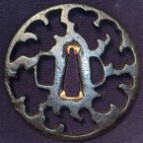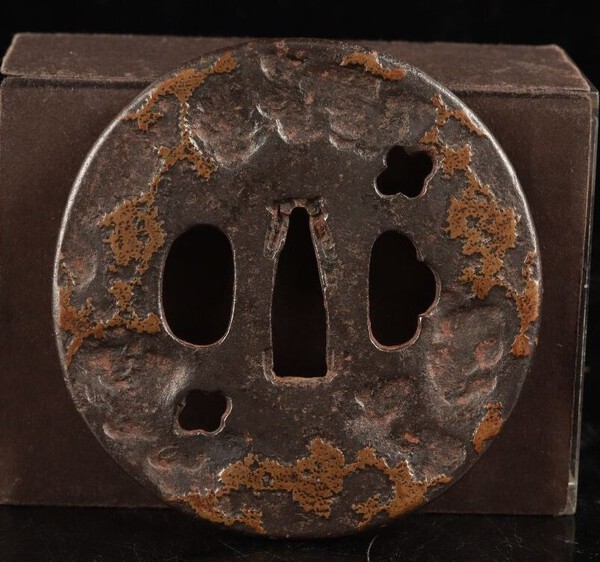-
Posts
696 -
Joined
-
Last visited
-
Days Won
13
Content Type
Profiles
Forums
Events
Store
Downloads
Gallery
Everything posted by GRC
-
And just a "quick note" to correct some misconceptions: The "low crossbar" smith is not gimei as David stated. I believe it was he or perhaps Curran who submitted one of the smaller Yamakichibei low crossbar "atelier works" for shinsa. These smaller ones are typically signed with a low-crossbar mei, but lack the telltale signs that they were made by the "low crossbar" master smith himself. Hence being "lesser works" that were produced in greater numbers by unknown smiths who signed with a similar loss crossbar mei. That lesser work that was submitted for shinsa came back as gimei and was posted on this forum at some point. Proper low crossbar works made by the mainline master smith, show the same method of production, styling and type of steel that are obviously consistent with the other Yakakichibei mainline smiths that predate the so-called "third generation smith" from the early Edo period. Incidentally, the "third gen" smith is often referred to as "Sakurayama" due to his use of a sakura flower stamp on the right side of the nakago-ana. The inconsistencies in Yamakichibei papers written by the NBTHK, are just another illustration of the utter dogmatic ignorance of that shinsa organization. Very early on in their existence, they arbitrarily adopted a "traditional view" of a mandatory 1st, 2nd, 3rd generation lineage for Yamakichibei tsuba makers based on the three most obviously distinct styles that were signed Yamakichibei. They simply didn't know enough to distinguish between the various mainline smiths that worked in a similar style to the smith they call shodai. So the NBTHK's lack of ability to discern among the various mainline smiths, and dogmatic adherence to their original 1st-3rd generation concept, means they are permanently stuck in a position to blindly lump all the early mainline smiths together under the banner of shodai (1st)... or "gimei" if it has even a slightly different aesthetic from the works they deem to be "shodai" In summary, NBTHK papers for Yamakichibei tsuba are a complete disaster and often unrelaible. But the low crossbar smith is certainly one of the mainline Yamakichibei smiths. One longtime collector and perhaps the first North American Yamakichibei specialist (Bruce Kirkpatrick) even goes so far as to suggest that the low crossbar smith was the original shodai smith (something that Steve noted in his paper about Yamakichibei mei). Who the actual shodai smith was, will likely never be known for certain due to lack of hard factual evidence, so we can only theorize and come up with a "most likely?" scenario with some competing alternate theories... each with their own merits and deficiencies. For me, that's part of the appeal to this group of smiths... a nice mystery to sink my teeth into.
-
ya neither... generic late Edo no-name
-
At a quick glance, that tsuba has a distinct "later Higo style" influence... The Hosokawa clan (specifically Hosokawa Tadaoki, the main driving force behind the entire Higo aesthetic) didn't even get to Higo province until 1632. And, more importantly the tsuba is signed by YANAGAWA NAOMASA (1692-1757) So between those little factual nuggets and the relative untouched newness of the whole Koshirae... it would appear to date sometime from the early to mid 1700s, and that's even going with the generous assumption that it's all original and dates to the same time that the tsuba was made (which is highly unlikely anyway). I don't see how it could possibly get papered to the Tensho era... almost 200 years earlier in the late 1500's. Oh wait, how could I forget... the papers are meaningless and those organizations will paper anything to anyone or any era, on any given day. You just have to know the right people or grease the right palms, and voila. This is just another example of the complete sham that the papering system is built upon.
-
This is what it should look like... These particular tsuba tend to get deep pitting when they corrode. It's due to the particular nature of the steel they were using (whatever the specific composition of elements was).
-
Edo period tsuba that was neglected and badly rusted and corroded... likely went through a fire first for it to have lost its entire original surface. this tsuba should have had a perfectly smooth surface. The lacquer was certainly done in the modern era to try to fancy up a destroyed tsuba. There are no period tsuba with lacquer done like that. I hope that’s not too blunt. But those are the facts.
-
Here's another Frankenstein mash-up of "schools" and papers... Heianjo encrustation on an obvious Tenpo plate (with stamps, although not prominently obvious), and with papers to... Shoami!!! Really????? At least pick Heianjo or Tenpo... but Shoami is ridiculous It's almost like the pressure to choose one or the other obvious one was too problematic it blurs the lines within the inadequate list of categories to slot things into, so the judges decided to skirt the issue and give it a completely different, unrelated attribution. It's the only rationale i can think of that might explain such decision. ...or too much sake maybe?
-
I'm guessing you meant Dale as in @Spartancrest?
-
This wouldn't be an issue at all because you don't quench the tang. The possibility of a "stress point" from the punched hole creating a traveling crack line to where the blade is being quenched, would be nearly impossible in my opinion. One caveat: I have never personally made a sword... but sure have watched a lot of Forged in Fire lol With regard to probable method, regardless of whether it was a tsuba, a sword tang, or armor: I put my money on punching. I say this having done some precision punch work in a blacksmithing workshop two years ago. It was the first time I had done it, and it didn't take long to get a very precise hole punched. I even had an initial mishit on one of them, and it was really easy to adjust my punch angle and course correct it. You mark a spot with a chisel that has a finer point, then punch your way maybe 4/5 of the way down with your hot punch, then flip it over and the punched area is thinned so much that it cools faster and looks black compared to the rest of the dull red hot metal around it, with one or two taps with the punch, the "plug" just pops out. The punch is tapered a little so that it smooths out the inside of the hole as you drive through a little at the end of the process. This whole process is very quick (and certainly precise if done by any moderately skilled blacksmith) and would have been the faster method of production until such time as there was a mechanical means of drilling. That's my two cents... but as @ROKUJURO said, I wasn't there, and there's no period documentation to say one way or another.
-
Stay away from both... Top one is almost certainly a modern repro that was used on an Iaido or replica sword, that's why it has the seppa-zuri (rust around the seppa-dai, where the brass seppa "spacer" was sitting. There's lots of things like that being sold today on many sites that sell Iai related items. Frankly, I'm amazed that the second one with the animals even exists... that's honestly one of the worst renditions of someone's "idea" of what a tsuba may be... almost like the maker had never seen one before and was just given some verbal description of what one might look like. Harsh judgement, I know... but that's my honest take on it. It's almost certainly made someplace other than Japan.
-
@Bugyotsuji Did you notice that the netsuke you posted is not just a pattern, but is actually a rain dragon surrounded by clouds? As far as I can tell, the drilling technique started in the Momoyama period (as was just about everything that is tsuba-related). Perhaps from gaining some new tech and influence from open trade with westerners and continental Asia… the the Japanese ran with it and perfected it (which seems to be their “thing”) I have seen very few tsuba that have what appear to be random holes… pretty much every time, there is a definitive intent to make a pattern or design using the the tools and techniques available. There’s pretty much nothing “random” or incidental when working with steel… sure there’s the occasional “happy accident”, but it’s a very deliberate process, filled with planning and mindful execution. So nearly 100% of the time, the pattern you see was intentional, not just secondary. I honestly think you’d almost have to go back to the stone age or earlier to get things that were just incidental patterns created by humans.
-
Steve, re your tsuba that started this thread: the patina seems to have been lost or abraded off at some point in its history, which doesn’t help. But it’s small size, focus on symmetry (I would almost certainly say clouds), and lack of any evidence of hand forging on the plate (no bones or hammer marks), place it squarely in the time in the Edo period when tsuba production was a sort of “free for all”. This was done to meet the demand from the growing merchant class who could openly wear wakizashi or tanto, but not katana and who now had more buying power. So this tsuba could have been made by any blacksmith at the time, who was busy producing tsuba of just about any style imaginable… …and not one of the expensive “jewelry” type machi-bori tsuba… which likely went mostly to the merchant class based on their being mostly wakizashi sized tsuba. Only the large sized ones would have gone to the richer samurai who were basically bureaucrats at that point anyway. Frankly almost everything else that was being made during the mid to late Edo period were just repeats from a “generic” product line to some degree or another… mostly derivative copies of widely accepted patterns, even if it was a higher end piece from Choshu, Bushu, Kinai or Akasaka for example. Tsuba at this point were mostly made by craftsmen rather than “artists” so to speak. Almost a “paint by numbers” kind of situation. Even the high end “art” tsuba of the late Edo period were mostly derivative copies of well known paintings and motifs… just beautifully executed with opulence, by very skilled jeweller-type craftsman.
-
Hi Steve. Glad you can see the more organic asymmetry of this particular komorebi motif. Looks like it was done in a pretty narrow window of time too… late Momoyama to early Edo. Almost as soon as the Edo period kicked in, with all its regulations that enforced conformity, out of fear of having the unification fall apart due to subversive “thinking outside the box”, and individual expressionism… this type of Momoyama “looseness” was quickly suppressed.
-
hmmm... anyone notice something unusual to the left of this post?
-
Oh, and NOT Akasaka... these predate their work for certain. Again, "Akasaka" or "Ko-Akasaka" were just labels of convenience because they didn't know what else to call them. The more I look at the existing papering and labeling system derived from Akiyama, Torigoye, Sasano, Haynes, the NBTHK (all of the same lineage of thought and categorizations), the more it "sheds light" on the tragedy that it is... ...
-
These two are a Japanese concept called "komorebi" 木漏れ日... dappled sunlight "leaking" through trees. Either looking up through the branches and/or the resulting dancing light and shadows cast on the ground. To my knowledge, it's a motif whose conceptualization in relation to tsuba sukashi, was first realized by Bruce Kirkpatrick. I discovered the correct name for it (komorebi) through some extensive searching on Japanese sites... and some luck. You won't see that motif stated by major papering organizations because it doesn't fall into their narrow set of pre-existing labels. As with all papering institutions, if it doesn't fit into an existing label, make it fit... because it must have a label... Bruce and I have many tsuba from this un-named maker, and hope to put together a paper on his works some day He's been chasing down this rabbit hole for years... I happened to stumble on the same path and am now going down the same rabbit hole. lol The rest of the tsuba on this post (other than the shippo ones) are showing clouds and/or clouds with geese, a much more common motif that was produced by many tsuba makers for centuries.
-
Sorry to say, but everything about that tsuba is Shoami, not Higo. To my knowledge, there aren't any examples of Higo tsuba with this carved wood bark effect. The nunome on the mimi and the hitsu-ana are definitely not Higo. Yes, there are some late Jingo tsuba with spiders on them, but they look dramatically different to this. If I had to to pick a group, i would suggest Aizu-Shoami. Hope that helps.
-
Edo period for sure, due to design and rope edge... and has nothing to do with Momoyama-ness
-
Love the added hitsu-ana on that thick one @Steves87 All these sukashi kiku tsuba are great examples of late Muromachi-early Edo period tsuba. That is clearly the window of time that they came into being, not earlier, and they were very popular throughout that time frame. There's absolutely no evidence to suggest they were made earlier than that... just pie in the sky theory.
-
@KungFooey Dee, your Akao tsuba is obviously legit and has a correct mei. There's absolutely no reason to doubt that your tsuba was made by that group of smiths. Do not waste your money on Shinsa for this tsuba. The money you'll you spend on papers for this will NEVER get recouped. You may as well just throw the, what is it now $250USD?, in the toilet and be done with it. Better still, give it to a charity of your choice so that your hard earned money is put to good use rather than giving it to some kind of flawed, predatory tosogu appraisal society. You're free to spend your money however you see fit of course, but that's just my advice. And welcome aboard by the way... don't let the dipshits dissuade you @Shugyosha, that's a great idea about disallowing people on someone's block list from using the anonymous emoji icons on that person's posts. If they choose to make a comment, they should post in words and have their profile name attached to it... at least there's some accountability that way.
-
Re: anchor tsuba ...and any unsigned, thick iron tsuba, with a rope pattern edge Somehow, somewhere, someone planted the idea that roped edged tsuba can be Ohno tsuba. I have no idea where that idea came from, but there's absolutely no evidence or justification to support that connection. They are far more likely to be Edo period "Tochibata" tsuba, like this one that was posted in the "maritime tsuba thread" ... which incidentally has the exact same round tegane punch marks on the nakago-ana as the Ohno one posted above, albeit in a different positional placement, plus the same kozuka hitsu-ana, and overall nakago-ana shape. Clearly these were made in the same time frame and from the same group of tsubako... whoever they were. But the community at large, as well as the NBTHK is happy to basically flip a coin and attribute it to either school, on any given day. https://www.militaria.co.za/nmb/topic/36547-maritime-tsuba/
-
Interestingly enough, as is often the case with ChatGPT summaries, it is so broadly "distilled" as to be virtually unusable. It sounds good upon first reading, but seriously lacks detail. You could use that very same set of criteria that it listed for Ohno, to describe almost any of the school constructs that are grouped in with "Owari-Momoyama-ness": ie. Owari, Kanayama, and Yagyu tsuba (although Yagyu tsuba were later than the rest)... ,but it definitely does not describe Yamakichibei tsuba (where round shapes are the exception rather than the more typical mokko or lobed shapes, and irregular asymmetry in the sukashi pattern and execution is nearly always the norm). Note: I have tried ChatGPT many times in the past, and even made some past NMB posts using its results, only to discover multiple flaws and limitations of using ChatGPT ) Oh and, Happy new year by the way
-
Thanks for the correction Curran Clearly not getting enough sleep these days, and should have double checked that before posting lol
-
I recall reading that the original lineage of Ohno smiths gave up making tsuba and became ship builders sometime around the mid-Edo period. So if that mokko tsuba is from that area and late Edo, then it has no connection to the original group, other than that it was made in the same area. It really does look remarkably different from all the other type of tsuba that have been labeled as "Ohno" so far. It's an interesting thing to dig into though... wonder if that smith's name comes in in a meikan? ...hopefully with a date and lineage
-
Curran, congrats on completing your daisho. That's always so satisfying. There's some nice tsuba in this thread, but... collectively, these are fine examples of how no one has any clue what an Ohno tsuba might actually be. It's just another "catch all" category for thick, unsigned, somewhat lumpy surfaced, sukashi tsuba (ranging from simple geometric symmetry to more elaborate but still simple "scenes") that don't fit nicely into any other bins. Oddly enough, there are some real out of character smooth ones posted on here as well... There's quite a few tsuba posted here that I would quickly disregard as being "Ohno", but that's based on my own preconceived notion of what fits in this mythical category. We know that these tsuba makers actually existed, but we don't know for certain what specific types of tsuba they produced (again no period documentation to tell us what they made). @Curran, where do you see Ohno 大野 in the squared mokko shaped tsuba with the waves and the mei? Here's one of those more elaborate scenes of chidori (plover birds) flying above waves that gets binned and papered as "Ohno"














